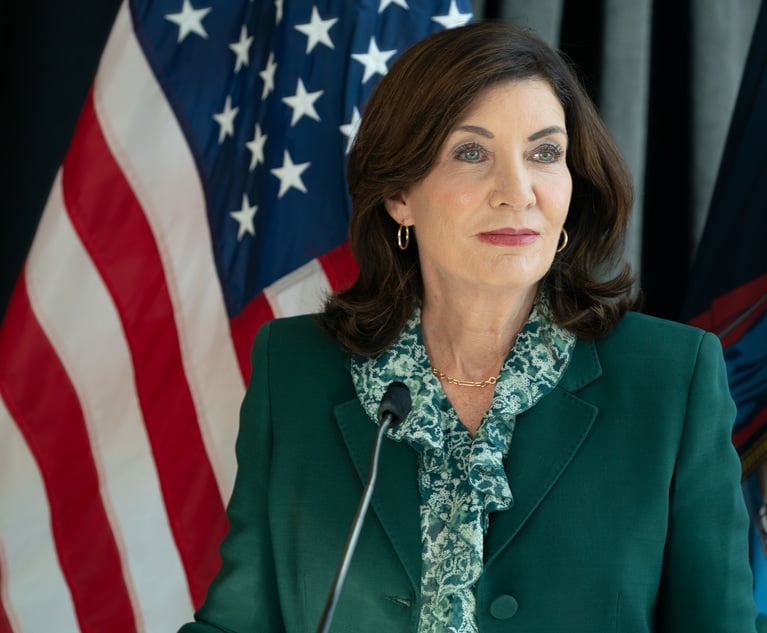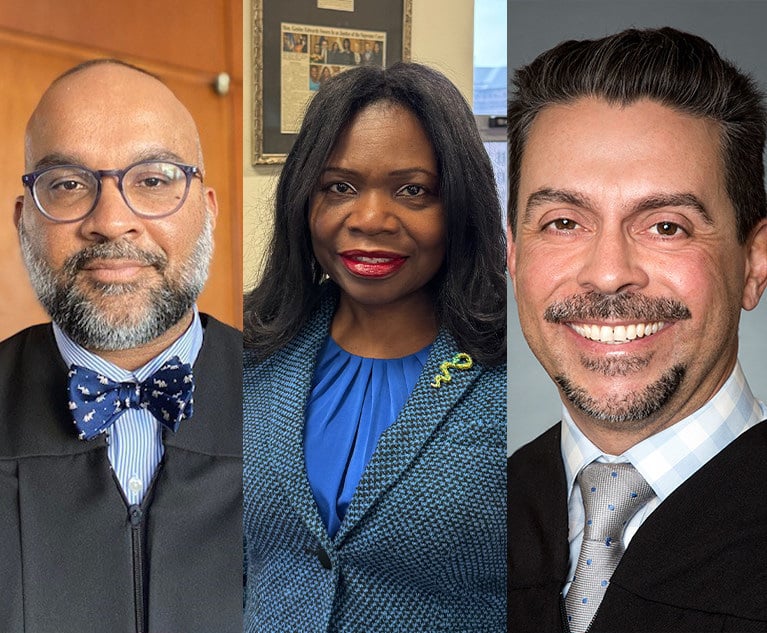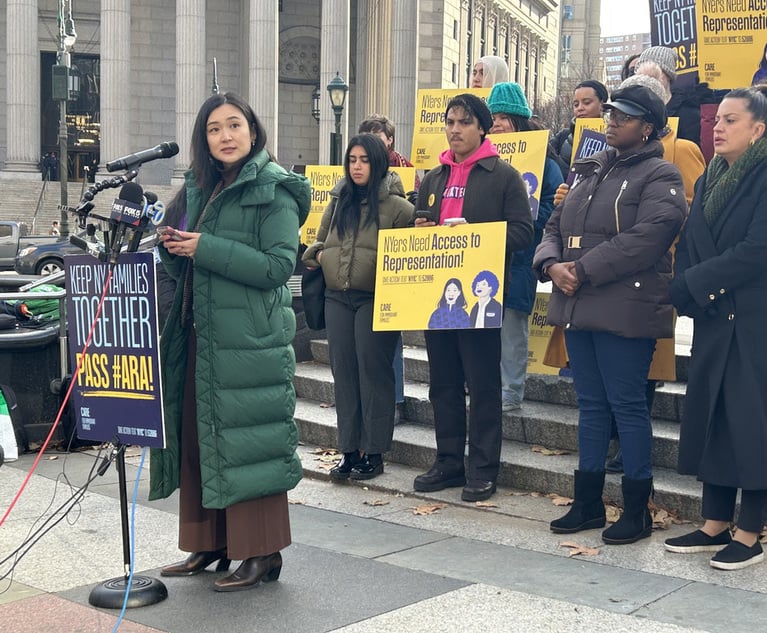New York Breaks From Federal Sexual Harassment Standards
In the wake of the #MeToo movement and other widespread focus on sexual and gender-based abuse, New York has adopted a number of legislative measures which break from the federal standards, seeking to more aggressively combat sexual harassment. These changes have come quickly, and employers operating in New York should be aware of them to ensure that they are adopting the policies necessary to comply with the new requirements.
October 04, 2019 at 11:30 AM
6 minute read
 Photo: bdstudio/Shutterstock.com
Photo: bdstudio/Shutterstock.com
While there have long been idiosyncrasies in New York state, city and local anti-discrimination laws, New York's laws against sexual harassment have traditionally mirrored federal standards, and thus sexual harassment claims brought under New York state law were "analyzed identically" to their federal counterparts. See Heskin v. InSite Aver., 2005 U.S. Dist. LEXIS 2546, *40, 2005 WL 407646 (S.D.N.Y. Feb. 22, 2005). Recently, however, in the wake of the #MeToo movement and other widespread focus on sexual and gender-based abuse, New York has adopted a number of legislative measures which break from the federal standards, seeking to more aggressively combat sexual harassment. These changes have come quickly, and employers operating in New York should be aware of them to ensure that they are adopting the policies necessary to comply with the new requirements.
Sexual Harassment Policies and Training Requirements
In 2018, the New York legislature and Gov. Andrew Cuomo enacted anti-sexual harassment reforms which impose stringent requirements for employers with respect to both sexual harassment policies and training.
Under the new law, which became effective Oct. 9, 2018, employers are required to implement a sexual harassment prevention policy and complaint procedure. The law has several stringent requirements as to what must be contained in such policies, and all employers operating in New York are required to adopt a policy that complies with these mandates. As such, even employers who already had a pre-existing anti-discrimination policy would be wise to have knowledgeable counsel review and update their policy to ensure that it complies with the new requirements. The New York State Department of Labor (NYSDOL) has published a model anti-harassment policy and model complaint form, which are available on its website, to provide guidance to employers and their counsel in crafting such policies.
The law also mandates that employers establish an annual, interactive sexual-harassment training program. While originally these training requirements were scheduled to take effect on Jan. 1, 2019, the NYSDOL and New York State Division of Human Rights (NYSDHR) pushed back the deadline to Oct. 9, 2019 for employers to complete their first annual training session. At a minimum, to comply with the law, the training must provide inter alia:
- An explanation of sexual harassment and specific examples of prohibited conduct.
- Sufficient information concerning federal, state and local anti-harassment laws, as well as remedies available to employees.
- A discussion of how employees can respond to unlawful conduct by supervisors and the additional responsibilities that supervisors have.
The law imposes additional requirements for the training, including that it be completed as soon as reasonable after each employee is hired, happen at least once per year, and be interactive. The NYSDOL has also published on its website certain tools and produced videos that employers can utilize in formulating the requisite training program.
2019 Legislative Sexual Harassment Reforms
Seemingly on the heels of the 2018 enactments, on Aug. 12, 2019 Governor Cuomo signed into law SB 6577, which creates several new protections and significantly enhances several existing protections against sexual harassment, as well as other forms of harassment and discrimination.
Perhaps the most notable aspect of the new law is New York's discarding of the "severe and pervasive" requirement to establish a claim of sexual harassment based upon a hostile environment and the need to provide a comparator to demonstrate discrimination. Since at least as early as 1986, when the U.S. Supreme Court in Meritor Sav. Bank, FSB v. Vinson removed any doubt that Title VII of the Civil Rights Act of 1964 prohibits sexual harassment based on a hostile workplace, as well as quid pro quo harassment, a claim based on a hostile work environment, to be actionable, must demonstrate harassment "sufficiently severe or pervasive to alter the conditions of the victim's employment and create an abusive working environment." See Meritor Sav. Bank, FSB v. Vinson, 477 U.S. 57, 67, 106 S. Ct. 2399, 2405, 91 L.Ed.2d 49, 60 (1986) (citations and quotations omitted). Now, under New York law, that standard does not apply, and it is the employer who must prove, as an affirmative defense, that a "reasonable victim" would view the conduct in question as no more than "petty slights or trivial inconveniences." This constitutes a substantial departure from the historical standards applied to hostile work environment claims.
Removal of the "severe or pervasive" threshold and removal of the plaintiff's need to establish a comparator are not the only reforms instituted by the new law, however. Additional provisions of this new law, most of which are effective as of Oct. 11, 2019 include, inter alia:
- An expanded definition of "employer" under the New York State Human Rights Law to include all employers regardless of size.
- Protections against unlawful discrimination for non-employees, such as independent contractors, vendors and consultants where the employer knew or should have known of unlawful discrimination occurring in the workplace and failed to take timely and appropriate remedial action.
- A repeal of Faragher/Ellerth as an affirmative defense, which protects employers where the employee fails to make a workplace complaint, for purposes of state discrimination claims.
- An extended time-limit, from one to three years, to file a complaint of sexual harassment with the NYSDHR.
- The availability of punitive damages in all employment discrimination cases and a requirement that the Court award attorney's fees to the prevailing party, unless the prevailing party is the defendant, in which case the defendant must first show that the complaint was frivolous.
- Prohibition of mandatory arbitration clauses with respect to all discrimination claims, although this provision is likely preempted by the Federal Arbitration Act. See ULatif v. Morgan Stanley & Co., No. 18-cv-11528 (DLC), 2019 WL 2610985, at *3-4 (S.D.N.Y. June 26, 2019) (invalidating a nearly identical provision in the 2018 bill that declared mandatory arbitration provisions unenforceable with respect to sexual harassment claims).
- Prohibition of non-disclosure provisions in agreements settling discrimination claims, except in very limited situations.
The new law also imposes additional requirements with respect to employer notification of sexual harassment policies and training requirements.
Conclusion
While employers operating in New York and their counsel have long been able to expect that if their policies and procedures comply with federal anti-discrimination and harassment requirements, that they are largely in-line with state requirements, such is no longer the case. The New York legislature has recently shown its willingness to break with federal standards and requirements, to enact laws which will more aggressively prevent and address sexual and other harassment, and there is no reason to expect that this trend will end anytime soon. Accordingly, now more than ever before, counsel for New York employers must be aware of these new legislative developments and be proactive in ensuring that their clients have enacted and updated their policies and practices to be in full compliance.
Russell Penzer is a partner at Lazer Aptheker Rosella & Yedid.
This content has been archived. It is available through our partners, LexisNexis® and Bloomberg Law.
To view this content, please continue to their sites.
Not a Lexis Subscriber?
Subscribe Now
Not a Bloomberg Law Subscriber?
Subscribe Now
NOT FOR REPRINT
© 2025 ALM Global, LLC, All Rights Reserved. Request academic re-use from www.copyright.com. All other uses, submit a request to [email protected]. For more information visit Asset & Logo Licensing.
You Might Like
View All
So Who Won? Congestion Pricing Ruling Leaves Both Sides Claiming Victory, Attorneys Seeking Clarification
4 minute read
Hochul Vetoes 'Grieving Families' Bill, Faulting a Lack of Changes to Suit Her Concerns

Court System Names New Administrative Judges for New York City Courts in Leadership Shakeup
3 minute read
Trending Stories
- 1'It's Not Going to Be Pretty': PayPal, Capital One Face Novel Class Actions Over 'Poaching' Commissions Owed Influencers
- 211th Circuit Rejects Trump's Emergency Request as DOJ Prepares to Release Special Counsel's Final Report
- 3Supreme Court Takes Up Challenge to ACA Task Force
- 4'Tragedy of Unspeakable Proportions:' Could Edison, DWP, Face Lawsuits Over LA Wildfires?
- 5Meta Pulls Plug on DEI Programs
Who Got The Work
Michael G. Bongiorno, Andrew Scott Dulberg and Elizabeth E. Driscoll from Wilmer Cutler Pickering Hale and Dorr have stepped in to represent Symbotic Inc., an A.I.-enabled technology platform that focuses on increasing supply chain efficiency, and other defendants in a pending shareholder derivative lawsuit. The case, filed Oct. 2 in Massachusetts District Court by the Brown Law Firm on behalf of Stephen Austen, accuses certain officers and directors of misleading investors in regard to Symbotic's potential for margin growth by failing to disclose that the company was not equipped to timely deploy its systems or manage expenses through project delays. The case, assigned to U.S. District Judge Nathaniel M. Gorton, is 1:24-cv-12522, Austen v. Cohen et al.
Who Got The Work
Edmund Polubinski and Marie Killmond of Davis Polk & Wardwell have entered appearances for data platform software development company MongoDB and other defendants in a pending shareholder derivative lawsuit. The action, filed Oct. 7 in New York Southern District Court by the Brown Law Firm, accuses the company's directors and/or officers of falsely expressing confidence in the company’s restructuring of its sales incentive plan and downplaying the severity of decreases in its upfront commitments. The case is 1:24-cv-07594, Roy v. Ittycheria et al.
Who Got The Work
Amy O. Bruchs and Kurt F. Ellison of Michael Best & Friedrich have entered appearances for Epic Systems Corp. in a pending employment discrimination lawsuit. The suit was filed Sept. 7 in Wisconsin Western District Court by Levine Eisberner LLC and Siri & Glimstad on behalf of a project manager who claims that he was wrongfully terminated after applying for a religious exemption to the defendant's COVID-19 vaccine mandate. The case, assigned to U.S. Magistrate Judge Anita Marie Boor, is 3:24-cv-00630, Secker, Nathan v. Epic Systems Corporation.
Who Got The Work
David X. Sullivan, Thomas J. Finn and Gregory A. Hall from McCarter & English have entered appearances for Sunrun Installation Services in a pending civil rights lawsuit. The complaint was filed Sept. 4 in Connecticut District Court by attorney Robert M. Berke on behalf of former employee George Edward Steins, who was arrested and charged with employing an unregistered home improvement salesperson. The complaint alleges that had Sunrun informed the Connecticut Department of Consumer Protection that the plaintiff's employment had ended in 2017 and that he no longer held Sunrun's home improvement contractor license, he would not have been hit with charges, which were dismissed in May 2024. The case, assigned to U.S. District Judge Jeffrey A. Meyer, is 3:24-cv-01423, Steins v. Sunrun, Inc. et al.
Who Got The Work
Greenberg Traurig shareholder Joshua L. Raskin has entered an appearance for boohoo.com UK Ltd. in a pending patent infringement lawsuit. The suit, filed Sept. 3 in Texas Eastern District Court by Rozier Hardt McDonough on behalf of Alto Dynamics, asserts five patents related to an online shopping platform. The case, assigned to U.S. District Judge Rodney Gilstrap, is 2:24-cv-00719, Alto Dynamics, LLC v. boohoo.com UK Limited.
Featured Firms
Law Offices of Gary Martin Hays & Associates, P.C.
(470) 294-1674
Law Offices of Mark E. Salomone
(857) 444-6468
Smith & Hassler
(713) 739-1250






